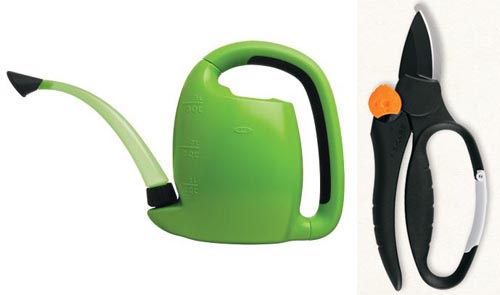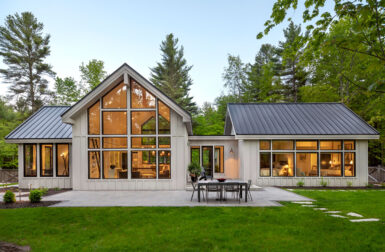
Now that the weather is changing and Spring is upon us, it’s time to start thinking about your garden. But what does a modern, urban gardener plant? I’m certainly no plant expert, and that’s why I caught up with Gayla Trail of You Grow Girl, urban gardening expert. She recently published a new book called Grow Great Grub. Gayla’s other book, You Grow Girl: The Groundbreaking Guide to Gardening is on my wishlist right now because as soon as I get a house, I’m getting a garden.
For those of you who are just starting out, you might have some of the same questions that I did, so check out our interview with Gayla:
Now that it’s Spring, what types of flowers or plants can urban dwellers begin planting now?
That depends on where you are located and the climate. In the southern United States gardeners are putting their tomatoes in or have already. In the Northeast, we are only just planting our tomato seeds indoors and won’t be putting them outside for a few months yet. It’s been an unseasonably warm spring so I suspect I will be planting peas, lettuce, mustard greens, spinach, violas and pansies soon enough. I sow the pea and leafy greens seeds directly into the soil outside — sowing indoors is unnecessary since they are cool weather plants. The chives have already started to sprout up from the thawing soil. They’re one of the earliest edible harbingers of spring on my roof garden.
Are there any specific species that you would recommend for high-rise apartment dwelling? In your experience what is the best surviving plant for small spaces?
Anything will grow in a container if the container is large enough to accommodate the mature size of the plant. That said, some plants just don’t yield well in pots, no matter the size. Leafy greens including mizuna, mustard greens, frisée, cress, lettuce, radicchio, and mâche all produce well in containers but the trick is to start early. They are watery plants that can’t take summer heat. Heat tolerant herbs such as thyme, oregano, lavender, and sage do well. You can grow a bunch of them in a towering “strawberry pot” (a pot with pockets along the sides) that will allow you to make use of vertical space in very tight quarters.

Black Seaman tomato and Purple Plum radishes [Photos: Gayla Trail/You Grow Girl]
Hot peppers tend to do better in pots than in the ground because you can control the intensity of their flavor by controlling the amount of water they receive. If you’re really short on space try a tiny variety that will grow in a small pot called ‘Chinese Ornamental.’ There are a surprising number of dwarf and miniature versions of larger plants available that can be grown in tight spots. ‘Tom Thumb’ pea is the shortest little pea plant you’ll ever see; yet it yields a pretty good haul. I love ‘Black Seaman,’ ‘Whippersnapper,’ and ‘Sophie’s Choice’ tomatoes in 12” pots. ‘Purple Plum’ is a pretty radish that can be easily grown in a window box and ‘Salad Bush’ is a cute little cucumber vine that fairs well in a 10 or 12-inch-deep pot.
What about those of us without a green thumb? What would you recommend for us?
I don’t really believe in green thumbs and black thumbs. I think that some people have a natural inclination to gardening, but being good at it is really just about observation, commitment, and experience. All gardeners kill plants. All gardeners are always learning and every season is a new opportunity to try again with what you’ve learned.
One mistake many beginners make is choosing a plant that won’t thrive in the environment they’ve got. You can avoid a certain amount of heartache if you’re honest with yourself about the intensity of light you’ll be working with before heading out the store. If you’ve got full sun (6+ hours of direct sun per day) then you’ll have a greater chance of success with most edibles including tomatoes, peppers, zucchini, eggplant, and a wise variety of Mediterranean herbs. If you’ve got partial sun (4-6 hours of direct sun per day) then I suggest leafy greens, mint, lemon balm, sorrel, spinach, and chives (to name a few).
If you’re forgetful about watering, choose borage, dill, hot peppers, thyme, oregano and other plants that don’t mind short periods of drought. You can also combat this problem by growing in oversized containers or planter boxes that won’t dry out as quickly as small pots.
What are five tools that you would recommend to a new/rookie urban gardener?
One of the biggest misconceptions about gardening is that you need a lot of specialized and expensive tools. Not true! Small space and container gardeners can get away with using a spoon and fork or just their hands if need be. A reader once wrote to tell me that she was so eager to get her garden started that she used the sharp end of a hammer to dig. You can’t argue with what works!
Still, tools are fun and a special new tool has a way of making us feel ready to tackle a new task. Since most of us are on a limited budget I suggest purchasing one good-quality digging tool rather than wasting money on a set of cheap tools that will crumble in hard soil on the first day. That said, my best trowels were about 8 bucks each at a hardware store and have lasted a decade. The key is in their construction. Look for hand trowels and hoes that are made of a solid, rust-resistant metal and firmly attached to the handle. A watering can is a good idea whether you’re gardening in ground or in pots, but buckets work too.

You’ll probably need something to cut with, whether it’s to harvest veggies and herbs or prune back old growth. Any pair of sharp scissors is handy for harvesting herbs. I often use my finger nails on tender, new growth (the technique is called “pinching back”). A moderately-priced pair of bypass pruners will suffice for cutting back thicker stems and branches. I like this one from Fiskars that attaches to my belt loop so I don’t lose it in the garden.
Gloves aren’t entirely essential and many gardeners (like me) prefer to put their hands in the soil. I’ve come to accept a certain amount of dirt underneath my fingernails through the growing months! I wear gloves when I am working with thorny plants like roses or cleaning up my street garden where there are a lot of discarded items of suspicious origin. For that reason I stick with less comfortable but impenetrable waterproof gloves. Anything with a leather patch around the fingers works to protect your hands from thorns.
Thanks for the tips, Gayla!
And to our readers, happy planting!







